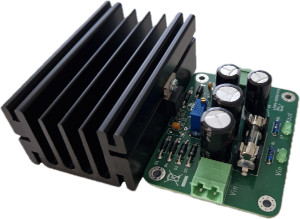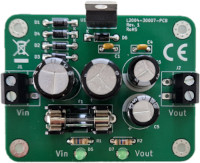Alimentatore stabilizzato variabile - 1.25V - 24V 1A
In ogni laboratorio non può mancare un alimentatore stabilizzato. In particolare, ogni sistema elettronico ha bisogno di un’alimentazione, e a seconda dei casi, il range di tensione, corrente e quindi potenza necessaria, può variare. Gli alimentatori a tensione fissa, presentati nel progetto PJ2007 permettono di realizzare alimentatori dedicati o avere l’opzione per tensioni comuni, quali 3.3V, 5V, 12V con schede già montate. Sebbene il progetto PJ2007 offra anche altri valori di tensione, l’alimentatore variabile permette di raggiungere lo scopo con un solo sistema. Infatti è possibile impostare la tensione positiva in un range molto ampio, da 1.25V a 24V e supportare una corrente fino ad 1A. Il progetto PJ2008 supporta inoltre sia l’opzione con potenziometro, al fine di realizzare un alimentatore da banco, che con trimmer multi-giri, permettendo di realizzare alimentatori dedicati, come per i progetto PJ2007, ma tensione impostabile ad un qualunque valore nel range supportato.
Alimentatore stabilizzato - 3.3V - 24V 1A
In ogni laboratorio non può mancare un alimentatore stabilizzato. In particolare, ogni sistema elettronico ha bisogno di un’alimentazione, e a seconda dei casi, il range di tensione, corrente e quindi potenza necessaria, può variare. Un alimentatore che soddisfi ogni esigenza è insolito e potrebbe essere piuttosto costoso. Quelli da banco possono coprire tipicamente 30-60V Vmax e 100W, con una buona regolazione. Usare sempre un alimentatore da banco per piccoli sistemi può non sempre essere conveniente. L’alimentatore presentato copre un range di tensione 3.3V-24V, cambiando il regolatore lineare montato sul PCB. Con pochi euro si possono dunque realizzare degli alimentatori dedicati, senza doversi affidare ad un alimentatore da banco.
Corso KiCad - Realizzare PCB professionali
Realizzare un PCB non richiede solamente imparare ad utilizzare un CAD dedicato allo scopo. Infatti, molte caratteristiche che deve avere il PCB, sebbene siano supportate dal CAD, rappresentano spesso solo un aiuto alla progettazione. Altri elementi devono essere aggiunti al fine di realizzare un PCB professionale. Alcuni aspetti sono stati esposti nei Capitoli precedenti e verranno ripresi in questo Capitolo, come raccolta delle caratteristiche principali di un PCB professionale.
Corso KiCad - Realizzare una libreria personale
L'ambiente di sviluppo KiCad viene fornito con molte librerie, per cui si può iniziare a progettare senza dover necessariamente crearne di proprie. Le necessità che possono portare alla realizzazione di una propria libreria sono generalmente le seguenti:
• Realizzare una propria libreria con i componenti più usati.
• All’interno di una società si può far uso solo di librerie approvate.
• Il componente che si vuole realizzare non è disponibile.
In particolare si vedranno i vari casi, e in base alla situazione, ci si troverà a dover realizzare il simbolo elettrico del componente, il footprint (impronta) e il modello 3D del componente stesso.
PCBWay - anniversario 10 anni
La scatola di montaggio stampata per mezzo della stampante 3D, permette di proteggere il sistema mini Sensing, sia esso formato dalla semplice scheda di sviluppo base o con schede di espansione. La lista sotto mostra alcuni modelli, che a seconda delle esigenze, possono soddisfare diversi casi di assemblaggio. Alcuni modelli verranno aggiunti con il tempo.
Registrati al sito
Accedi a tutte le risorse e articoli non visibili pubblicamente, puoi registrarti con pochi passi.
Login
Online
Abbiamo 150 ospiti e nessun utente online



